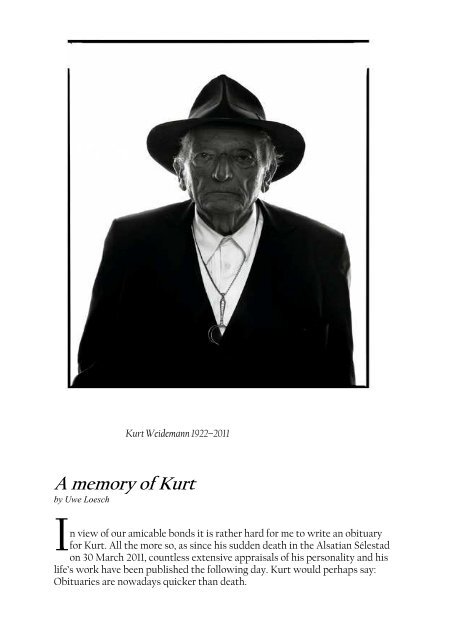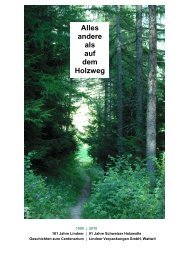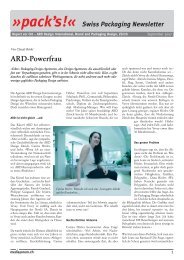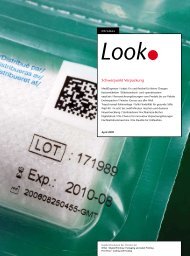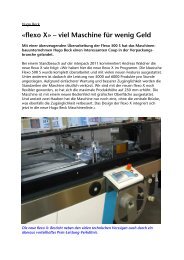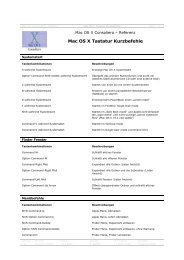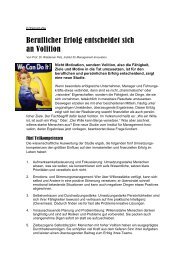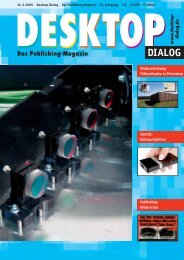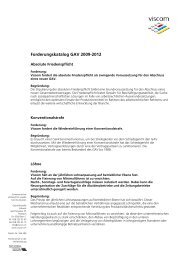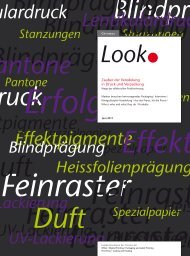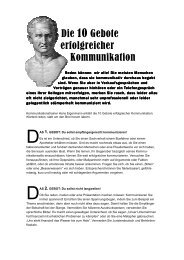You also want an ePaper? Increase the reach of your titles
YUMPU automatically turns print PDFs into web optimized ePapers that Google loves.
<strong>Kurt</strong> Weidemann 1922–2011<br />
A <strong>memory</strong> <strong>of</strong> <strong>Kurt</strong><br />
by Uwe Loesch<br />
I<br />
n view <strong>of</strong> our amicable bonds it is rather hard for me to write an obituary<br />
for <strong>Kurt</strong>. All the more so, as since his sudden death in the Alsatian Sélestad<br />
on 30 March 2011, countless extensive appraisals <strong>of</strong> his personality and his<br />
life’s work have been published the following day. <strong>Kurt</strong> would perhaps say:<br />
Obituaries are nowadays quicker than death.
<strong>Kurt</strong> Weidemann was a polemical man, a master <strong>of</strong> aphorisms and words,<br />
which always have to be balanced. "Wo der Buchstabe das Wort führt.<br />
Ansichten über Schrift und Typografie" ("Where the letter leads the word.<br />
Views on typeface and typography") was the title <strong>of</strong> one <strong>of</strong> his best<br />
publications. Above all he was a sought-after speaker at congresses and<br />
symposia at which, even in advanced age, he knew excellently to awaken the<br />
interest <strong>of</strong> inquisitive students. <strong>Kurt</strong> was not only worshipped and admired,<br />
but he was celebrated worldwide by innumerous young fans.<br />
Mission-conscious as he was, one day he penned the Ten Commandments for<br />
the designer. If you re-read them today you get the impression that <strong>Kurt</strong><br />
somehow wrote his own obituary. In the first Commandment it says: "Love<br />
your pr<strong>of</strong>ession like yourself and in such a way, that if you are reborn, you don’t<br />
want any other pr<strong>of</strong>ession, even if it is only for the purpose <strong>of</strong> mending what<br />
you did wrong or what you hadn’t finished. Exchange every day <strong>of</strong> your life for<br />
something meaningful. It is irretrievable. The Today can’t be retrieved in the<br />
Tomorrow. Future and hope are a sequence <strong>of</strong> Today. In work lies the chance to<br />
find to yourself."<br />
In fact <strong>Kurt</strong> had a busy life in survival. In 1922 he was born into poor<br />
circumstances in East-Prussia, he grew up in Lübeck. As enthusiastic volunteer<br />
he participated in World War II and only narrowly escaped death in 1941. Via<br />
the shock he lost his voice and had to regain his speech laboriously. From 1945<br />
to 1950 he survived the Russian captivity in a stone quarry at the lower Wolga.<br />
In 2002 he published with critical distance the impressions about those years,<br />
straight and unadulterated in the book "Kaum ich" (Hardly me).<br />
W<br />
ith scarcely 30 years he began his "second life" with an<br />
apprenticeship as typesetter in Lübeck and then studied book<br />
design and typography from 1953 until 1955 at The Stuttgart State<br />
Academy <strong>of</strong> Art and Design. From 1955 onwards he worked as freelance graphic<br />
designer, advertising consultant and copywriter. From 1955 – 1964 he worked<br />
as sub-editor and type director for the magazine "Der Druckspiegel". Together<br />
with Aaron Burns he set up the International Center for the Typographic Arts<br />
(ICTA) in New York City at the beginning <strong>of</strong> the 1960s. And he was the<br />
president <strong>of</strong> ICTA from 1966 to 1972. In the year 1965 he was appointed<br />
pr<strong>of</strong>essor for information and graphic design practice at The Stuttgart State<br />
Academy <strong>of</strong> Art and Design. The pr<strong>of</strong>essorship had been established specially<br />
for him and he taught there for twenty years. In 1975 he was admitted to the<br />
AGI. At the beginning <strong>of</strong> the 1980s he participated in the foundation <strong>of</strong> the<br />
WHU – Otto Beisheim School <strong>of</strong> Management in Vallendar and taught there<br />
from 1983 onwards. From 1970 until 1972 he was president <strong>of</strong> Icograda.<br />
Furthermore he directed the Stuttgarter Künstlerhaus for 7 years. Apart from<br />
lecturing at the WHU he taught from 1991, at the age <strong>of</strong> nearly 70, at the<br />
Karlsruhe University <strong>of</strong> Arts and Design.
<strong>Kurt</strong> never liked to set up a "big shop" for corporate communication. For many<br />
years an exceedingly punctual and loyal employee equally called <strong>Kurt</strong> worked<br />
for him. The small, however fine studio in Stuttgart received important jobs<br />
from well-known companies. <strong>Kurt</strong> and <strong>Kurt</strong> designed or redesigned the<br />
corporate design <strong>of</strong> co-op, Zeiss, Merck, Mercedes-Benz, Daimler-Benz,<br />
Deutsche Aerospace, Porsche und Deutsche Bahn. Furthermore he designed<br />
books for the Büchergilde Gutenberg as well as for the publishers Ullstein,<br />
Propyläen, Ernst Klett und Thieme. The "Biblica", "Corporate ASE" and the "ITC<br />
Weidemann" are some <strong>of</strong> his most famous typefaces.<br />
Because <strong>of</strong> his versatile activities as designer and consultant, pr<strong>of</strong>essor and<br />
author he was awarded with many prizes and honorary memberships, such as:<br />
in 1995 with the Lucky Strike Designer Award <strong>of</strong> the Raymond-Loewy-<br />
Foundation and a year later with the Order <strong>of</strong> Merit <strong>of</strong> the Federal Republic <strong>of</strong><br />
Germany.<br />
In the book "<strong>Kurt</strong> Weidemann. Biografische Gespräche mit Heike Schiller &<br />
Arne Braun" (biographical talks) he discloses also his private family-life. <strong>Kurt</strong><br />
was married twice. After the tragic death <strong>of</strong> his second wife he became "singleparent"<br />
<strong>of</strong> his three children. With the exploration <strong>of</strong> his very eventful<br />
biography it struck me that he had a full life in spite <strong>of</strong> all strokes <strong>of</strong> fate, so<br />
that it is easy for me to say goodbye to him with greatest respect. I think all<br />
members <strong>of</strong> the AGI will remember him with fondness.<br />
— Uwe Loesch, President <strong>of</strong> the German AGI members


